Between 1914 and 1958, Cecil B. DeMille (1881-1959) made 70 silent and sound films. He is a founding father of the American cinema and the most commercially successful producer-director in film history. DeMille is synonymous with religious epics: The Ten Commandments (1923 and 1956), The King of Kings (1927), and Samson and Delilah (1949). He blended spectacle, sex, and spellbinding narrative to convey a message of faith. His silent films also included social dramas, comedies, and Westerns. DeMille created the image of the omnipotent director, megaphone in hand, wearing boots and a visored cap. DeMille created numerous stars: Wallace Reid, Gloria Swanson, William Boyd, Claudette Colbert, Jean Arthur, and Charlton Heston.

Spanish collectors card in the series 'Los artistas cinematograficos en la intimidad' by Amatller, Barcelona, Series A. From left to right: Thomas Meighan, Jeanie MacPherson, Lois Wilson, Cecil B. DeMille, Conrad Nagel, and Gloria Swanson. The photo was made during a visit to Nagel's villa, part of one of the biggest acacia plantations in California.

German postcard by Ross Verlag, no. 86/6. Photo: National-Film. Victor Varconi, H.B. Warner, and Rudolph Schildkraut in The King of Kings (Cecil B. De Mille, 1927). Caption: Caiphas accuses Jesus before Pontius Pilate.

Spanish postcard, no. 1012. Elissa Landi and Fredric March in The Sign of the Cross (Cecil B. De Mille, 1932).
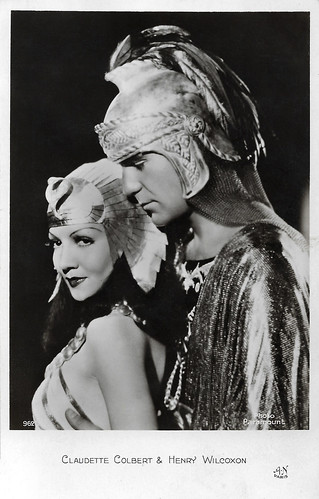
French postcard by A.N., Paris, no. 962. Photo: Paramount. Claudette Colbert and Henry Wilcoxon in Cleopatra (Cecil B. DeMille, 1934).
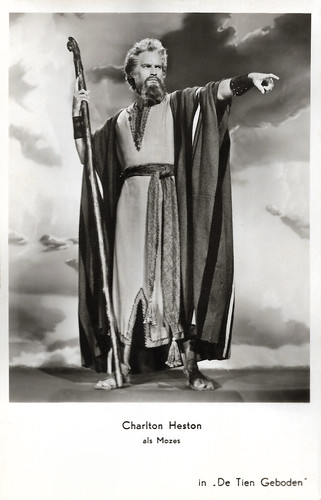
Dutch postcard by Gebr. Spanjersberg N.V., Rotterdam, no. 5183. Photo: Paramount. Charlton Heston as Moses in The Ten Commandments (Cecil B. DeMille, 1956). Moses' robe was hand-woven by Dorothea Hulse, one of the world's finest weavers. She also created costumes for The Robe, as well as textiles and costume fabrics for Samson and Delilah, David and Bathsheba, and others.
Cecil Blount DeMille was born in 1881 in a boarding house on Main Street in Ashfield, Massachusetts, where his parents had been vacationing for the summer. He was the second of three children of Henry Churchill DeMille and his wife Matilda Beatrice DeMille. His brother, William C. DeMille, was born in 1878, and would later become a director too.
Cecil grew up in New York City where his father worked as a playwright, administrator, and faculty member during the early years of the American Academy of Dramatic Arts, established in New York City in 1884. DeMille's mother Beatrice was a literary agent and scriptwriter. Henry DeMille frequently collaborated with stage producer David Belasco when playwriting. Cecil gained his love of theatre while watching his father and Belasco rehearse their plays.
His father died when he was 12, and his mother supported the family by opening a school for girls and a theatrical company. DeMille attended and graduated in 1900 from the American Academy of Dramatic Arts, where he attended for free due to his father's service to the Academy. His graduation performance was the play 'The Arcady Trail'. In the audience was Charles Frohman who would cast DeMille in his play 'Hearts are Trumps', DeMille's Broadway debut.
At the age of twenty-one, Cecil B. DeMille married actress Constance Adams in 1902. They had a daughter, Cecilia, in 1908, who would be his only biological child. For twelve years he was actor/manager of his mother's theatrical company. DeMille performed on stage with actors whom he would later direct in films: Charlotte Walker, Mary Pickford, and Pedro de Cordoba.
In the 1910s, he began to direct stage productions. A collaboration of DeMille and Jesse Lasky, who was then a vaudeville producer, produced a successful musical called 'California' which opened in New York in January 1912. DeMille also produced many flops and he became disinterested in working in theatre. DeMille's passion for film was ignited when he watched the French film Les Amours de la Reine Élisabeth/Queen Elizabeth (Henri Desfontaines, Louis Mercanton, 1912) starring Sarah Bernhardt and Lou Tellegen.
Desiring a change of scene, Cecil B. DeMille, Jesse Lasky, Sam Goldfish (later Samuel Goldwyn), and a group of East Coast businessmen created the Jesse L. Lasky Feature Play Company in 1913 over which DeMille became director-general. His first film was The Squaw Man (Oscar Apfel, Cecil B. DeMille, 1914), with Dustin Farnum in the lead role. It was also the first full-length feature film shot in Hollywood. Its interracial love story made it commercially successful and it first publicised Hollywood as the home of the American film industry.
DeMille's next project was the comedy Brewster's Millions (Oscar Apfel, Cecil B. DeMille, 1914), which was wildly successful. Cecil B. DeMille's second film credited exclusively to him was the Western The Virginian (Cecil B. DeMille, 1914), again starring Dustin Farnum. DeMille had directed twenty films by 1915, including successes as Rose of the Rancho (Cecil B. De Mille, 1914) with Bessie Barriscale, and the haunted-house horror film The Ghost Breaker (Cecil B. DeMille, Oscar C. Apfel, 1914).
Wikipedia: "DeMille adapted Belasco's dramatic lighting techniques to film technology, mimicking moonlight with U.S. cinema's first attempts at "motivated lighting" in The Warrens of Virginia. This was the first of few film collaborations with his brother William." DeMille also created the posts of studio story editor, art director, and concept artist. In December 1914, Constance Adams brought home John DeMille, a fifteen-month-old, whom the couple legally adopted three years later.
DeMille's most successful film was The Cheat (Cecil B. De Mille, 1916) with Fannie Ward and Sessue Hayakawa. DeMille's direction in the film was acclaimed. In 1916, the Jesse Lasky Feature Play Company merged with Adolph Zukor's Famous Players Film Company, becoming Famous Players-Lasky. Zukor became president with Lasky as the vice president. DeMille was maintained as director-general and Goldwyn became chairman of the board.
One of its first successes was the historical epic Joan the Woman (Cecil B. De Mille, 1916) with Geraldine Farrar. It was the first film to use the Handschiegl Color Process. In 1920, DeMille and Adams adopted Katherine Lester whom Adams had found in the orphanage over which she was the director. In 1922, the couple also adopted Richard DeMille.

British postcard. Fannie Ward in The Cheat (Cecil B. DeMille, 1915).
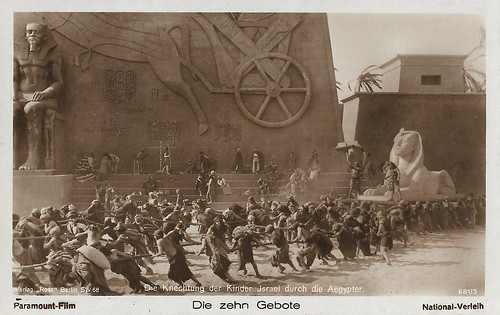
German postcard by Ross Verlag, no. 681/3. Photo: Paramount-Film / National-Verleih. Publicity still for The Ten Commandments (Cecil B. DeMille, 1923). Caption: The Slavery of the Children of Israel by the Egyptians.

French postcard, no. 492. Jesus (H.B. Warner) between the Virgin Mary (Dorothy Cumming) and Mary Magdalene (Jacqueline Logan) in The King of Kings (Cecil B. DeMille, 1927).

German postcard by Ross Verlag, no. 86/4. Photo: National Film. Jacqueline Logan in The King of Kings (Cecil B. deMille, 1927). Caption: Mary Magdalene dries Jesus' feet.

Dutch postcard by N.V. De Faam, Breda. Photo: Metro-Goldwyn-Mayer. Lillian Roth in Madam Satan (Cecil B. DeMille, 1930).
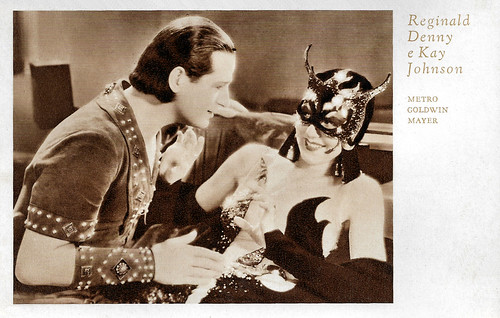
Italian postcard by Cinema-Illustrazione, Milano, Serie 2, no. 30. Photo: Metro-Goldwyn-Mayer. Kay Johnson and Reginald Denny in Madam Satan (Cecil B. DeMille, 1930).

German postcard by Ross Verlag, no. 176/12. Photo: Paramount. Elissa Landi in the American epic The Sign of the Cross (Cecil B. DeMille, 1932), based on the original 1895 play by Wilson Barrett.
After five years and thirty hit films, Cecil DeMille became the American film industry's most successful director. DeMille's trademark scenes included bathtubs, lion attacks, and Roman orgies. A number of his films featured scenes in two-color Technicolor.
His first biblical epic, The Ten Commandments (Cecil B. De Mille, 1923) starring Theodore Roberts, was both a critical and commercial success. The film was produced on a large budget of $600,000, the most expensive production at Paramount. However, the film turned out to be the studio's highest-grossing film. It held the Paramount revenue record for twenty-five years.
When a censorship board called the Hays Code was established, DeMille's depiction of on-screen immorality came under fire. DeMille left Paramount in 1924 despite having helped establish it. Instead, he joined the Producers Distributing Corporation. DeMille directed The King of Kings (Cecil B. De Mille, 1927), a biography of Jesus, which gained approval for its sensitivity and reached more than 800 million viewers. The Kings of Kings established DeMille as "master of the grandiose and of biblical sagas".
In the silent era, he was further renowned for Male and Female (Cecil DeMille, 1919) with Thomas Meighan and Gloria Swanson, Manslaughter (Cecil DeMille, 1922) with Meighan and Leatrice Joy, The Volga Boatman (Cecil DeMille, 1926) with William Boyd, and The Godless Girl (Cecil DeMille, 1928) with Marie Prevost.
When sound film was introduced in 1928, Cecil B. DeMille made a successful transition. He devised a microphone boom and a soundproof camera blimp and also popularised the camera crane. The Sign of the Cross (Cecil B. DeMille, 1932) is said to be the first sound film to integrate all aspects of cinematic technique. Cleopatra (Cecil B. DeMille, 1934) starring Claudette Colbert was his first film to be nominated for the Academy Award for Best Picture.
From 1936 to 1945 he hosted and directed the hour-long 'Lux Radio Theatre', which brought the actors and stories of many films to the airwaves and further established him as the symbol of Hollywood. In these years, his fame as a filmmaker was surpassed by his fame as a radio star. In 1939, Union Pacific (Cecil B. DeMille, 1939) was successful through DeMille's collaboration with the Union Pacific Railroad. The Union Pacific gave DeMille access to historical data, early period trains, and expert crews, adding to the authenticity of the film.
DeMille first used three-strip Technicolor in North West Mounted Police (Cecil B. DeMille, 1940). DeMille wanted to film in Canada; however, due to budget constraints, the film was instead shot in Oregon and Hollywood. Critics were impressed with the visuals but found the scripts dull, calling it DeMille's "poorest Western". Despite the criticism, it was Paramount's highest-grossing film of the year.
In 1942, DeMille released Paramount's most successful film, Reap the Wild Wind (Cecil B. DeMille, 1942). It was produced with a large budget and contained many special effects including an electronically operated giant squid. DeMille's subsequent film Unconquered (Cecil B. DeMille, 1947) with Gary Cooper, had the longest running time (146 minutes), longest filming schedule (102 days) and largest budget of $5 million. The sets and effects were so realistic that 30 extras needed to be hospitalised due to a scene with fireballs and flaming arrows. It was commercially very successful.

British postcard in the series Film Shots by Film Weekly. Photo: Paramount. Charles Laughton and Claudette Colbert in The Sign of the Cross (Cecil B. De Mille, 1932).

British postcard in the series Film Shots by Film Weekly. Photo: Paramount. Fredric March in The Sign of the Cross (Cecil B. De Mille, 1932).

British postcard in the Colourgraph Series, no. C248. Photo: Paramount. Henry Wilcoxon as King Richard in the period piece The Crusades (Cecil B. DeMille, 1935).

British postcard in the Film Partners Series, London, no. P 243. Photo: Paramount. Fredric March and Franziska Gaal in The Buccaneer (Cecil B. DeMille, 1938).

German postcard by Ross Verlag, no. A 1462/1, 1937-1938. Photo: Paramount. Franziska Gaal a.k.a. Franceska Gaal in The Buccaneer (Cecil B. DeMille, 1938).

German postcard by F.J. Rüdel, Filmpostkarten-Verlag, Hamburg-Bergedorf, no. 211. Photo: Paramount. Paulette Goddard in Unconquered (Cecil B. DeMille, 1947).

French postcard by Editions P.I., Paris, no. 307. Photo: Paramount. Gary Cooper in Unconquered (Cecil B. DeMille, 1947).
After more than thirty years in film production, Cecil DeMille reached a pinnacle in his career with Samson and Delilah (Cecil DeMille, 1949), starring Victor Mature and Hedy Lamarr. This biblical epic with sex became the highest-grossing film of 1950. He appeared as himself in the classic Sunset Boulevard (Billy Wilder, 1950) with his former star Gloria Swanson as the fictitious disturbed former silent film actress Norma Desmond.
DeMille received his first nomination for the Oscar for Best Director for his circus drama The Greatest Show on Earth (Cecil DeMille, 1952), starring James Stewart, Cornel Wilde, and Betty Hutton. It won both the Oscar and the Golden Globe for Best Picture. Ringling Brothers-Barnum and Bailey were paid $250,000 for use of the title and facilities. DeMille toured with the circus while helping write the script. Noisy and bright, it was not well-liked by critics but was a favorite among audiences.
His last and best-known film, The Ten Commandments (Cecil DeMille, 1956), starring Charlton Heston and Yul Brynner. It was the longest (3 hours, 39 minutes) and most expensive ($13 million) film in Paramount history. The Exodus scene was filmed on-site in Egypt with the use of four Technicolor-VistaVision cameras filming 12,000 people. They continued filming in 1955 in Paris and Hollywood on 30 different sound stages. Post-production lasted a year and the film premiered in Salt Lake City. Nominated for an Academy Award for Best Picture, it grossed over $80 million, which surpassed the gross of The Greatest Show on Earth and every other film in history, except for Gone with the Wind.
In 1954, while in Egypt filming the Exodus sequence, the 73-year-old DeMille climbed a 33 m ladder to the top of the massive Per Rameses set and suffered a serious heart attack. Despite the urging of his associate producer, DeMille wanted to return to the set right away. DeMille developed a plan with his doctor to allow him to continue directing while reducing his physical stress. Although DeMille completed the film, his health was diminished by several more heart attacks, and this film would be his last.
Due to his frequent heart attacks, DeMille asked his son-in-law, actor Anthony Quinn, to direct a remake of his 1938 film The Buccaneer. DeMille served as executive producer, overseeing producer Henry Wilcoxon.
Cecil B. De Mille died in 1959 following a heart attack. He was entombed at the Hollywood Memorial Cemetery, now known as Hollywood Forever. In addition to his Best Picture Awards, Cecil B. DeMille received an Academy Honorary Award for his film contributions, the Palme d'Or (posthumously) for Union Pacific (1939), a DGA Award for Lifetime Achievement, and the Irving G. Thalberg Memorial Award. He was the first recipient of the Golden Globe Cecil B. DeMille Award, which was named in his honour.
DeMille’s authority extended beyond the confines of his studio. He was a power in aviation, banking, politics, and real estate, and he was one of the 36 co-founders of the Academy of Motion Picture Arts and Sciences (AMPAS). Although married to wife Constance Adams for fifty-six years, DeMille had long-term affairs with two other women: actress-writer Jeanie MacPherson and actress Julia Faye, occasionally entertaining both women simultaneously on his yacht or his ranch. His wife knew of the affairs but preferred to live with their children in the main house.
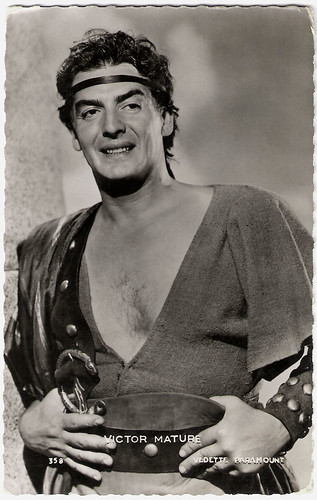
French postcard by Editions P.I., Paris, no. 358, 1954. Photo: Paramount Pictures Inc. Victor Mature in Samson and Delilah (Cecil B. DeMille, 1949).
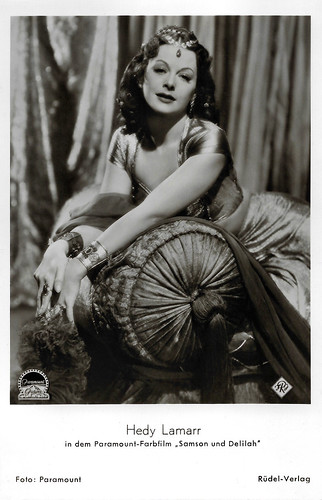
German postcard by Rüdel-Verlag, Hamburg-Bergedorf, no. 319. Photo: Paramount. Hedy Lamarr in Samson and Delilah (Cecil B. DeMille, 1949).

Dutch promotion card by Paramount Pictures. Photo: Paramount Pictures. Betty Hutton and Cornel Wilde in The Greatest Show on Earth (Cecil B. DeMille, 1952). Caption: Acrobatic tours in the skies of the cold-blooded Cornel Wilde and the no less skilled Betty Hutton in one of the most sensational scenes of The Greatest Show of Earth. Further protagonists are Charlton Heston, Dorothy Lamour, Gloria Grahame, and James Stewart.

Dutch promotion card by Paramount Pictures. Photo: Paramount Pictures. Betty Hutton in The Greatest Show on Earth (Cecil B. DeMille, 1952).

French postcard by Editions P.I., no. 830, 1956. Photo: Paramount Pictures Inc. Charlton Heston as Moses in The Ten Commandments (Cecil B. de Mille, 1956).

French postcard by Editions P.I., Paris, no. 831. Photo: Paramount. Yul Brynner in The Ten Commandments (Cecil B. DeMille, 1956). For his pursuit of the Israelites, Brynner in his role as Rameses II wears the blue Khepresh helmet-crown, which the pharaohs wore for battle.

Dutch postcard. Photo: Edward G. Robinson as Dathan in The Ten Commandments (Cecil B. deMille, 1956), released in the Netherlands as De Tien Geboden.

Dutch postcard, no. P. 13730. Photo: M.G.M. Cecil B. DeMille and Chief Little Bison
Sources: Ed Stephan (IMDb), CecilBDeMille.com, Wikipedia, and IMDb.

Spanish collectors card in the series 'Los artistas cinematograficos en la intimidad' by Amatller, Barcelona, Series A. From left to right: Thomas Meighan, Jeanie MacPherson, Lois Wilson, Cecil B. DeMille, Conrad Nagel, and Gloria Swanson. The photo was made during a visit to Nagel's villa, part of one of the biggest acacia plantations in California.

German postcard by Ross Verlag, no. 86/6. Photo: National-Film. Victor Varconi, H.B. Warner, and Rudolph Schildkraut in The King of Kings (Cecil B. De Mille, 1927). Caption: Caiphas accuses Jesus before Pontius Pilate.

Spanish postcard, no. 1012. Elissa Landi and Fredric March in The Sign of the Cross (Cecil B. De Mille, 1932).

French postcard by A.N., Paris, no. 962. Photo: Paramount. Claudette Colbert and Henry Wilcoxon in Cleopatra (Cecil B. DeMille, 1934).

Dutch postcard by Gebr. Spanjersberg N.V., Rotterdam, no. 5183. Photo: Paramount. Charlton Heston as Moses in The Ten Commandments (Cecil B. DeMille, 1956). Moses' robe was hand-woven by Dorothea Hulse, one of the world's finest weavers. She also created costumes for The Robe, as well as textiles and costume fabrics for Samson and Delilah, David and Bathsheba, and others.
U.S. cinema's first attempts at 'motivated' lighting
Cecil Blount DeMille was born in 1881 in a boarding house on Main Street in Ashfield, Massachusetts, where his parents had been vacationing for the summer. He was the second of three children of Henry Churchill DeMille and his wife Matilda Beatrice DeMille. His brother, William C. DeMille, was born in 1878, and would later become a director too.
Cecil grew up in New York City where his father worked as a playwright, administrator, and faculty member during the early years of the American Academy of Dramatic Arts, established in New York City in 1884. DeMille's mother Beatrice was a literary agent and scriptwriter. Henry DeMille frequently collaborated with stage producer David Belasco when playwriting. Cecil gained his love of theatre while watching his father and Belasco rehearse their plays.
His father died when he was 12, and his mother supported the family by opening a school for girls and a theatrical company. DeMille attended and graduated in 1900 from the American Academy of Dramatic Arts, where he attended for free due to his father's service to the Academy. His graduation performance was the play 'The Arcady Trail'. In the audience was Charles Frohman who would cast DeMille in his play 'Hearts are Trumps', DeMille's Broadway debut.
At the age of twenty-one, Cecil B. DeMille married actress Constance Adams in 1902. They had a daughter, Cecilia, in 1908, who would be his only biological child. For twelve years he was actor/manager of his mother's theatrical company. DeMille performed on stage with actors whom he would later direct in films: Charlotte Walker, Mary Pickford, and Pedro de Cordoba.
In the 1910s, he began to direct stage productions. A collaboration of DeMille and Jesse Lasky, who was then a vaudeville producer, produced a successful musical called 'California' which opened in New York in January 1912. DeMille also produced many flops and he became disinterested in working in theatre. DeMille's passion for film was ignited when he watched the French film Les Amours de la Reine Élisabeth/Queen Elizabeth (Henri Desfontaines, Louis Mercanton, 1912) starring Sarah Bernhardt and Lou Tellegen.
Desiring a change of scene, Cecil B. DeMille, Jesse Lasky, Sam Goldfish (later Samuel Goldwyn), and a group of East Coast businessmen created the Jesse L. Lasky Feature Play Company in 1913 over which DeMille became director-general. His first film was The Squaw Man (Oscar Apfel, Cecil B. DeMille, 1914), with Dustin Farnum in the lead role. It was also the first full-length feature film shot in Hollywood. Its interracial love story made it commercially successful and it first publicised Hollywood as the home of the American film industry.
DeMille's next project was the comedy Brewster's Millions (Oscar Apfel, Cecil B. DeMille, 1914), which was wildly successful. Cecil B. DeMille's second film credited exclusively to him was the Western The Virginian (Cecil B. DeMille, 1914), again starring Dustin Farnum. DeMille had directed twenty films by 1915, including successes as Rose of the Rancho (Cecil B. De Mille, 1914) with Bessie Barriscale, and the haunted-house horror film The Ghost Breaker (Cecil B. DeMille, Oscar C. Apfel, 1914).
Wikipedia: "DeMille adapted Belasco's dramatic lighting techniques to film technology, mimicking moonlight with U.S. cinema's first attempts at "motivated lighting" in The Warrens of Virginia. This was the first of few film collaborations with his brother William." DeMille also created the posts of studio story editor, art director, and concept artist. In December 1914, Constance Adams brought home John DeMille, a fifteen-month-old, whom the couple legally adopted three years later.
DeMille's most successful film was The Cheat (Cecil B. De Mille, 1916) with Fannie Ward and Sessue Hayakawa. DeMille's direction in the film was acclaimed. In 1916, the Jesse Lasky Feature Play Company merged with Adolph Zukor's Famous Players Film Company, becoming Famous Players-Lasky. Zukor became president with Lasky as the vice president. DeMille was maintained as director-general and Goldwyn became chairman of the board.
One of its first successes was the historical epic Joan the Woman (Cecil B. De Mille, 1916) with Geraldine Farrar. It was the first film to use the Handschiegl Color Process. In 1920, DeMille and Adams adopted Katherine Lester whom Adams had found in the orphanage over which she was the director. In 1922, the couple also adopted Richard DeMille.

British postcard. Fannie Ward in The Cheat (Cecil B. DeMille, 1915).

German postcard by Ross Verlag, no. 681/3. Photo: Paramount-Film / National-Verleih. Publicity still for The Ten Commandments (Cecil B. DeMille, 1923). Caption: The Slavery of the Children of Israel by the Egyptians.

French postcard, no. 492. Jesus (H.B. Warner) between the Virgin Mary (Dorothy Cumming) and Mary Magdalene (Jacqueline Logan) in The King of Kings (Cecil B. DeMille, 1927).

German postcard by Ross Verlag, no. 86/4. Photo: National Film. Jacqueline Logan in The King of Kings (Cecil B. deMille, 1927). Caption: Mary Magdalene dries Jesus' feet.

Dutch postcard by N.V. De Faam, Breda. Photo: Metro-Goldwyn-Mayer. Lillian Roth in Madam Satan (Cecil B. DeMille, 1930).

Italian postcard by Cinema-Illustrazione, Milano, Serie 2, no. 30. Photo: Metro-Goldwyn-Mayer. Kay Johnson and Reginald Denny in Madam Satan (Cecil B. DeMille, 1930).

German postcard by Ross Verlag, no. 176/12. Photo: Paramount. Elissa Landi in the American epic The Sign of the Cross (Cecil B. DeMille, 1932), based on the original 1895 play by Wilson Barrett.
Master of the grandiose and of biblical sagas
After five years and thirty hit films, Cecil DeMille became the American film industry's most successful director. DeMille's trademark scenes included bathtubs, lion attacks, and Roman orgies. A number of his films featured scenes in two-color Technicolor.
His first biblical epic, The Ten Commandments (Cecil B. De Mille, 1923) starring Theodore Roberts, was both a critical and commercial success. The film was produced on a large budget of $600,000, the most expensive production at Paramount. However, the film turned out to be the studio's highest-grossing film. It held the Paramount revenue record for twenty-five years.
When a censorship board called the Hays Code was established, DeMille's depiction of on-screen immorality came under fire. DeMille left Paramount in 1924 despite having helped establish it. Instead, he joined the Producers Distributing Corporation. DeMille directed The King of Kings (Cecil B. De Mille, 1927), a biography of Jesus, which gained approval for its sensitivity and reached more than 800 million viewers. The Kings of Kings established DeMille as "master of the grandiose and of biblical sagas".
In the silent era, he was further renowned for Male and Female (Cecil DeMille, 1919) with Thomas Meighan and Gloria Swanson, Manslaughter (Cecil DeMille, 1922) with Meighan and Leatrice Joy, The Volga Boatman (Cecil DeMille, 1926) with William Boyd, and The Godless Girl (Cecil DeMille, 1928) with Marie Prevost.
When sound film was introduced in 1928, Cecil B. DeMille made a successful transition. He devised a microphone boom and a soundproof camera blimp and also popularised the camera crane. The Sign of the Cross (Cecil B. DeMille, 1932) is said to be the first sound film to integrate all aspects of cinematic technique. Cleopatra (Cecil B. DeMille, 1934) starring Claudette Colbert was his first film to be nominated for the Academy Award for Best Picture.
From 1936 to 1945 he hosted and directed the hour-long 'Lux Radio Theatre', which brought the actors and stories of many films to the airwaves and further established him as the symbol of Hollywood. In these years, his fame as a filmmaker was surpassed by his fame as a radio star. In 1939, Union Pacific (Cecil B. DeMille, 1939) was successful through DeMille's collaboration with the Union Pacific Railroad. The Union Pacific gave DeMille access to historical data, early period trains, and expert crews, adding to the authenticity of the film.
DeMille first used three-strip Technicolor in North West Mounted Police (Cecil B. DeMille, 1940). DeMille wanted to film in Canada; however, due to budget constraints, the film was instead shot in Oregon and Hollywood. Critics were impressed with the visuals but found the scripts dull, calling it DeMille's "poorest Western". Despite the criticism, it was Paramount's highest-grossing film of the year.
In 1942, DeMille released Paramount's most successful film, Reap the Wild Wind (Cecil B. DeMille, 1942). It was produced with a large budget and contained many special effects including an electronically operated giant squid. DeMille's subsequent film Unconquered (Cecil B. DeMille, 1947) with Gary Cooper, had the longest running time (146 minutes), longest filming schedule (102 days) and largest budget of $5 million. The sets and effects were so realistic that 30 extras needed to be hospitalised due to a scene with fireballs and flaming arrows. It was commercially very successful.

British postcard in the series Film Shots by Film Weekly. Photo: Paramount. Charles Laughton and Claudette Colbert in The Sign of the Cross (Cecil B. De Mille, 1932).

British postcard in the series Film Shots by Film Weekly. Photo: Paramount. Fredric March in The Sign of the Cross (Cecil B. De Mille, 1932).

British postcard in the Colourgraph Series, no. C248. Photo: Paramount. Henry Wilcoxon as King Richard in the period piece The Crusades (Cecil B. DeMille, 1935).

British postcard in the Film Partners Series, London, no. P 243. Photo: Paramount. Fredric March and Franziska Gaal in The Buccaneer (Cecil B. DeMille, 1938).

German postcard by Ross Verlag, no. A 1462/1, 1937-1938. Photo: Paramount. Franziska Gaal a.k.a. Franceska Gaal in The Buccaneer (Cecil B. DeMille, 1938).

German postcard by F.J. Rüdel, Filmpostkarten-Verlag, Hamburg-Bergedorf, no. 211. Photo: Paramount. Paulette Goddard in Unconquered (Cecil B. DeMille, 1947).

French postcard by Editions P.I., Paris, no. 307. Photo: Paramount. Gary Cooper in Unconquered (Cecil B. DeMille, 1947).
The longest and most expensive film in Paramount history
After more than thirty years in film production, Cecil DeMille reached a pinnacle in his career with Samson and Delilah (Cecil DeMille, 1949), starring Victor Mature and Hedy Lamarr. This biblical epic with sex became the highest-grossing film of 1950. He appeared as himself in the classic Sunset Boulevard (Billy Wilder, 1950) with his former star Gloria Swanson as the fictitious disturbed former silent film actress Norma Desmond.
DeMille received his first nomination for the Oscar for Best Director for his circus drama The Greatest Show on Earth (Cecil DeMille, 1952), starring James Stewart, Cornel Wilde, and Betty Hutton. It won both the Oscar and the Golden Globe for Best Picture. Ringling Brothers-Barnum and Bailey were paid $250,000 for use of the title and facilities. DeMille toured with the circus while helping write the script. Noisy and bright, it was not well-liked by critics but was a favorite among audiences.
His last and best-known film, The Ten Commandments (Cecil DeMille, 1956), starring Charlton Heston and Yul Brynner. It was the longest (3 hours, 39 minutes) and most expensive ($13 million) film in Paramount history. The Exodus scene was filmed on-site in Egypt with the use of four Technicolor-VistaVision cameras filming 12,000 people. They continued filming in 1955 in Paris and Hollywood on 30 different sound stages. Post-production lasted a year and the film premiered in Salt Lake City. Nominated for an Academy Award for Best Picture, it grossed over $80 million, which surpassed the gross of The Greatest Show on Earth and every other film in history, except for Gone with the Wind.
In 1954, while in Egypt filming the Exodus sequence, the 73-year-old DeMille climbed a 33 m ladder to the top of the massive Per Rameses set and suffered a serious heart attack. Despite the urging of his associate producer, DeMille wanted to return to the set right away. DeMille developed a plan with his doctor to allow him to continue directing while reducing his physical stress. Although DeMille completed the film, his health was diminished by several more heart attacks, and this film would be his last.
Due to his frequent heart attacks, DeMille asked his son-in-law, actor Anthony Quinn, to direct a remake of his 1938 film The Buccaneer. DeMille served as executive producer, overseeing producer Henry Wilcoxon.
Cecil B. De Mille died in 1959 following a heart attack. He was entombed at the Hollywood Memorial Cemetery, now known as Hollywood Forever. In addition to his Best Picture Awards, Cecil B. DeMille received an Academy Honorary Award for his film contributions, the Palme d'Or (posthumously) for Union Pacific (1939), a DGA Award for Lifetime Achievement, and the Irving G. Thalberg Memorial Award. He was the first recipient of the Golden Globe Cecil B. DeMille Award, which was named in his honour.
DeMille’s authority extended beyond the confines of his studio. He was a power in aviation, banking, politics, and real estate, and he was one of the 36 co-founders of the Academy of Motion Picture Arts and Sciences (AMPAS). Although married to wife Constance Adams for fifty-six years, DeMille had long-term affairs with two other women: actress-writer Jeanie MacPherson and actress Julia Faye, occasionally entertaining both women simultaneously on his yacht or his ranch. His wife knew of the affairs but preferred to live with their children in the main house.

French postcard by Editions P.I., Paris, no. 358, 1954. Photo: Paramount Pictures Inc. Victor Mature in Samson and Delilah (Cecil B. DeMille, 1949).

German postcard by Rüdel-Verlag, Hamburg-Bergedorf, no. 319. Photo: Paramount. Hedy Lamarr in Samson and Delilah (Cecil B. DeMille, 1949).

Dutch promotion card by Paramount Pictures. Photo: Paramount Pictures. Betty Hutton and Cornel Wilde in The Greatest Show on Earth (Cecil B. DeMille, 1952). Caption: Acrobatic tours in the skies of the cold-blooded Cornel Wilde and the no less skilled Betty Hutton in one of the most sensational scenes of The Greatest Show of Earth. Further protagonists are Charlton Heston, Dorothy Lamour, Gloria Grahame, and James Stewart.

Dutch promotion card by Paramount Pictures. Photo: Paramount Pictures. Betty Hutton in The Greatest Show on Earth (Cecil B. DeMille, 1952).

French postcard by Editions P.I., no. 830, 1956. Photo: Paramount Pictures Inc. Charlton Heston as Moses in The Ten Commandments (Cecil B. de Mille, 1956).

French postcard by Editions P.I., Paris, no. 831. Photo: Paramount. Yul Brynner in The Ten Commandments (Cecil B. DeMille, 1956). For his pursuit of the Israelites, Brynner in his role as Rameses II wears the blue Khepresh helmet-crown, which the pharaohs wore for battle.

Dutch postcard. Photo: Edward G. Robinson as Dathan in The Ten Commandments (Cecil B. deMille, 1956), released in the Netherlands as De Tien Geboden.

Dutch postcard, no. P. 13730. Photo: M.G.M. Cecil B. DeMille and Chief Little Bison
Sources: Ed Stephan (IMDb), CecilBDeMille.com, Wikipedia, and IMDb.
No comments:
Post a Comment